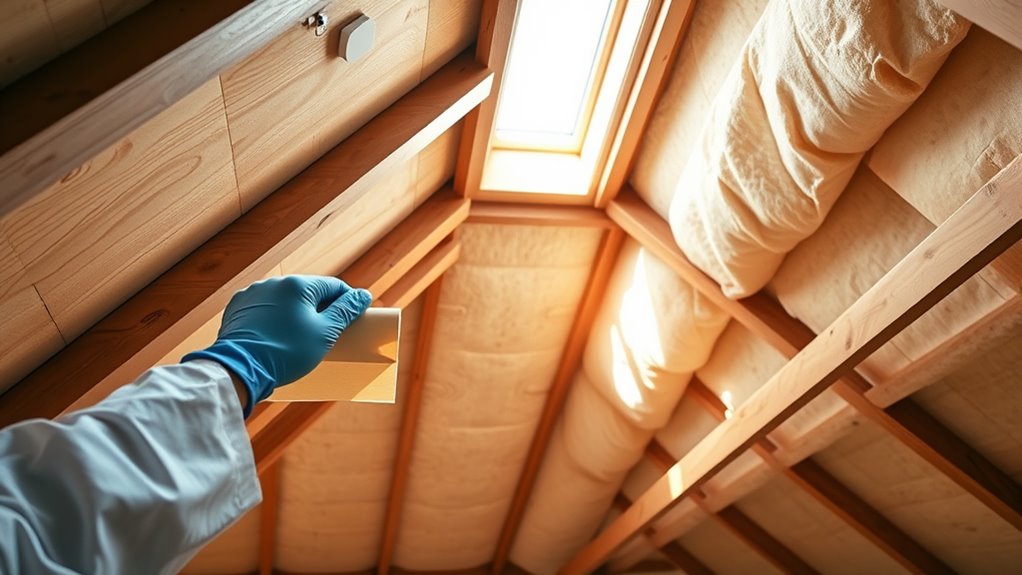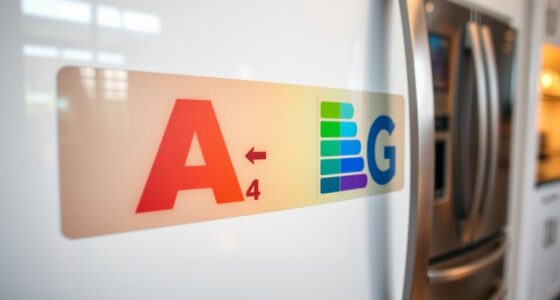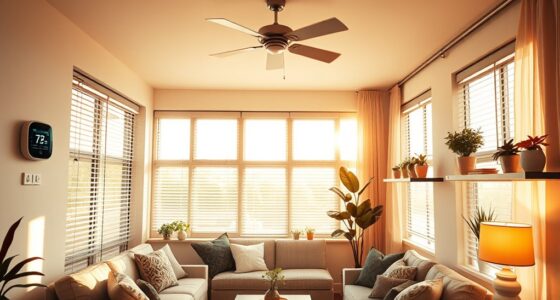You can improve your home’s insulation without major construction by sealing air leaks around doors, windows, and outlets with weatherstripping and caulk. Add or replace attic and basement insulation in accessible areas to boost thermal resistance. Insulate ductwork in unconditioned spaces to prevent energy loss. Using blown-in or spray foam insulation through small openings is also effective for hard-to-reach spots. These simple upgrades increase comfort and lower energy bills—discover more ways to enhance your home’s efficiency below.
Key Takeaways
- Add or replace attic and basement insulation using simple tools, avoiding extensive remodeling.
- Seal leaks around doors, windows, and outlets with weatherstripping and caulking for immediate energy savings.
- Use blown-in or spray foam insulation in wall cavities through small access holes with minimal disruption.
- Insulate HVAC ducts in unconditioned spaces to improve system efficiency without major renovations.
- Opt for non-disruptive upgrades that enhance comfort and reduce energy bills without significant construction.

Upgrading your insulation can substantially improve your home’s energy efficiency and comfort. You don’t need to tear down walls or undertake major construction projects to make a significant difference. Many effective insulation upgrades are straightforward and can be completed without significant disruption to your daily routine. This approach allows you to target problem areas, reduce energy costs, and enhance indoor comfort with minimal hassle.
One of the easiest ways to upgrade insulation is by adding or replacing batt or roll insulation in accessible areas, such as attic spaces or basement ceilings. If your attic insulation is old, compressed, or uneven, it’s likely not performing *at its best*. You can simply lift existing insulation and lay new batts on top, or remove old material and install fresh insulation. This improves thermal resistance and prevents heat loss during winter or heat gain in summer. There’s no need for extensive remodeling—just some basic tools and careful layering.
Another effective method involves sealing air leaks around doors, windows, and electrical outlets. Gaps and cracks allow warm or cool air to escape, making your HVAC system work harder. Use weatherstripping and caulking to seal these leaks efficiently. This step doesn’t involve adding insulation per se but enhances overall insulation effectiveness by preventing unwanted air exchange. It’s a quick, inexpensive fix that complements your existing insulation and can dramatically boost comfort and energy savings.
You might also consider blown-in or spray foam insulation in hard-to-reach areas, such as wall cavities or between floors, without taking down walls. Blown-in cellulose or fiberglass can be injected through small holes in the drywall, filling gaps and voids effectively. Spray foam, applied through small openings, expands to seal gaps and insulate simultaneously. Both options require minimal demolition—often just drilling small access points—and can be professionally installed to ensure even coverage and maximum performance.
Finally, don’t overlook insulation upgrades in your HVAC ductwork. Insulating ducts that run through unconditioned spaces prevents energy loss and maintains temperature consistency. You can wrap duct sections with foil or fiberglass insulation, which is simple to install and doesn’t require major renovations. Properly insulated ducts improve system efficiency and help keep your home more comfortable year-round.
With these strategies, you can achieve meaningful insulation upgrades without major construction. You’ll experience better temperature regulation, lower energy bills, and increased comfort—all without the mess or expense of extensive remodeling. It’s a practical way to improve your home’s energy performance while keeping disruptions to a minimum. Proper insulation techniques can make a significant difference in your home’s overall energy efficiency and comfort.
Frequently Asked Questions
What Insulation Types Require No Demolition?
You can install blown-in or spray foam insulation without demolition. Blown-in insulation, like cellulose or fiberglass, fits into existing walls, attics, or floors through small holes, making it ideal for upgrades without major work. Spray foam can be injected into wall cavities via small openings. Both options improve energy efficiency with minimal disruption, saving you time and money compared to traditional, invasive insulation methods.
How Long Does a Typical Insulation Upgrade Take?
A typical insulation upgrade takes anywhere from a few hours to a day, depending on the size of your space and the type of insulation used. If you’re opting for blown-in or spray foam insulation, it’s usually quick and minimally disruptive. You can expect the work to be completed efficiently, often within a single day, allowing you to enjoy improved energy efficiency without major downtime or construction mess.
Can Insulation Upgrades Improve Indoor Air Quality?
Yes, insulation upgrades can improve your indoor air quality. When you add or replace insulation, it reduces drafts and minimizes the entry of dust, pollen, and other airborne pollutants. Proper insulation also helps regulate humidity levels, preventing mold growth which can harm air quality. By sealing gaps and improving insulation, you create a healthier indoor environment, making your home more comfortable and safer for everyone inside.
Are There Any Health Risks With Certain Insulation Materials?
Certain insulation materials can pose health risks; for example, fiberglass may cause skin irritation and respiratory issues if fibers become airborne. Approximately 15% of people exposed to fiberglass report symptoms like coughing and itchy eyes. To stay safe, you should wear protective gear during installation and guarantee proper ventilation. Opt for less hazardous options like spray foam or mineral wool if you have sensitivities, and always follow manufacturer safety instructions.
What Is the Cost Range for Non-Invasive Insulation Upgrades?
The cost for non-invasive insulation upgrades typically ranges from $1,000 to $3,500, depending on your home’s size and the type of insulation used. You might spend less with spray foam or blown-in options, which are quick and minimally disruptive. To get the best deal, compare quotes from local contractors and consider the insulation material’s R-value for energy efficiency. This way, you save money and improve comfort without major construction.
Conclusion
Now that you know how simple upgrades can boost your home’s insulation, imagine what’s possible with just a few more tweaks. The comfort and savings waiting just beyond this step might surprise you—are you ready to discover the secrets to a warmer, more efficient home? Don’t stop here; your next upgrade could be the game-changer you’ve been waiting for. The best part? It’s easier than you think, and the results might just leave you speechless.









